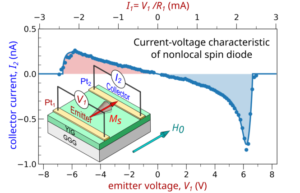Spin electronics applies to a wide range of materials: metals, where spin is transported by electrons, but also magnetic insulators, where spin is transported by magnons. The latter are of interest because in certain insulators, such as yttrium iron garnet (YIG), it is predicted that one could reach a state of superfluidity, i.e. spin transport without energy dissipation. In two recent papers, we have shown why this magnetic material does not live up to the expectations of ideal magnon transport.

Current-voltage characteristic curve of a spin diode made of YIG material conducting spin current via magnon propagating between two Pt electrodes.
A research team led by SPINTEC is trying to reproduce the nonlinear properties of diodes with spin conductors. They aim to electrically control spin currents carried by magnons. This area of research is of great interest because of the hope of obtaining an ideal diode device by achieving quantum condensation, known as Bose-Einstein condensation. A spin diode in this state would have perfect nonlinear properties, as it would carry spin currents without any loss of energy, in analogy to a superconductor, which allows the transport of electric current without resistance.
In two consecutive articles, we have studied nonlocal magnon transport in extended thin films of yttrium iron garnet (YIG), a remarkable material because of its highly favorable nonlinear threshold. The practical realization consists of a magnetic film on which two platinum wires are deposited, acting as magnon emitters and magnon collectors, respectively. These adjacent wires allow the electrical control of the magnon chemical potential by the spin transfer effect. A strong enhancement of the spin current is expected when the magnon chemical potential is shifted towards the gap of the magnon band.
We report that when the electrodes are sufficiently spaced, the device exhibits a diode-like current-voltage characteristic due to the nonlinear increase in the population of low-energy magnons. However, the gain obtained remains small, several orders of magnitude lower than expected (see figure). In a first paper, the researchers explain this setback by a rapid saturation of the low-energy magnon population, which limits the spin diode effect and thus fails to reach a state of large magnon concentration and hence large spin current. The whole material therefore behaves like a magnon liquid, but without the quantum effect. In the second article we explain why the diode effect can only be achieved at large distances between the electrodes. At short distances, the spin transport is dominated by the competing high-energy thermal magnons, which respond only linearly to the voltage applied between the electrodes. Fortunately, their contribution decays rapidly with distance, revealing the spin diode effect of low-energy magnons, which have a much larger characteristic decay length once the separation between the electrodes exceeds a few microns. The researchers propose an analytical model that integrates the effects of both low-energy magnons and thermal magnons, which confirms the experimental observations. These results show that it is not possible to achieve the formation of a Bose-Einstein condensate in the YIG material, but instead suggest that a magnetohydrodynamic fluid regime is formed at high power due to this increase in the spin-spin relaxation rate, as would occur in an ultrapure electronic conductor such as graphene, a phenomenon known as the Gurzhi effect.
Teams: Spin Insulatronics
Collaboration: SPEC, UBO, Lab. Albert Fert, Univ. De Lorraine
Funding: French Grants ANR-18-CE24-0021 Maestro, ANR-21-CE24-0031 Harmony; EU-Project HORIZON-EIC-2021-PATHFINDEROPEN PALANTIRI-101046630
Further reading: Nonlocal magnon transconductance in extended magnetic insulating films part I and II, R. Kohno, K. An, E. Clot, V. V. Naleto, N. Thiery, L. Vila, R. Schlitz, N. Beaulieu, J. B. Youssef, M. Anane, V. Cros, H. Merbouche, T. Hauet, V. E. Demidov, S. O. Demokritov, G. de Loubens, and O. Klein, Phys. Rev. B 108, 144410 and 144411 (2023). Open access: hal-04207174 & hal-04207180
Contact: Olivier KLEIN




